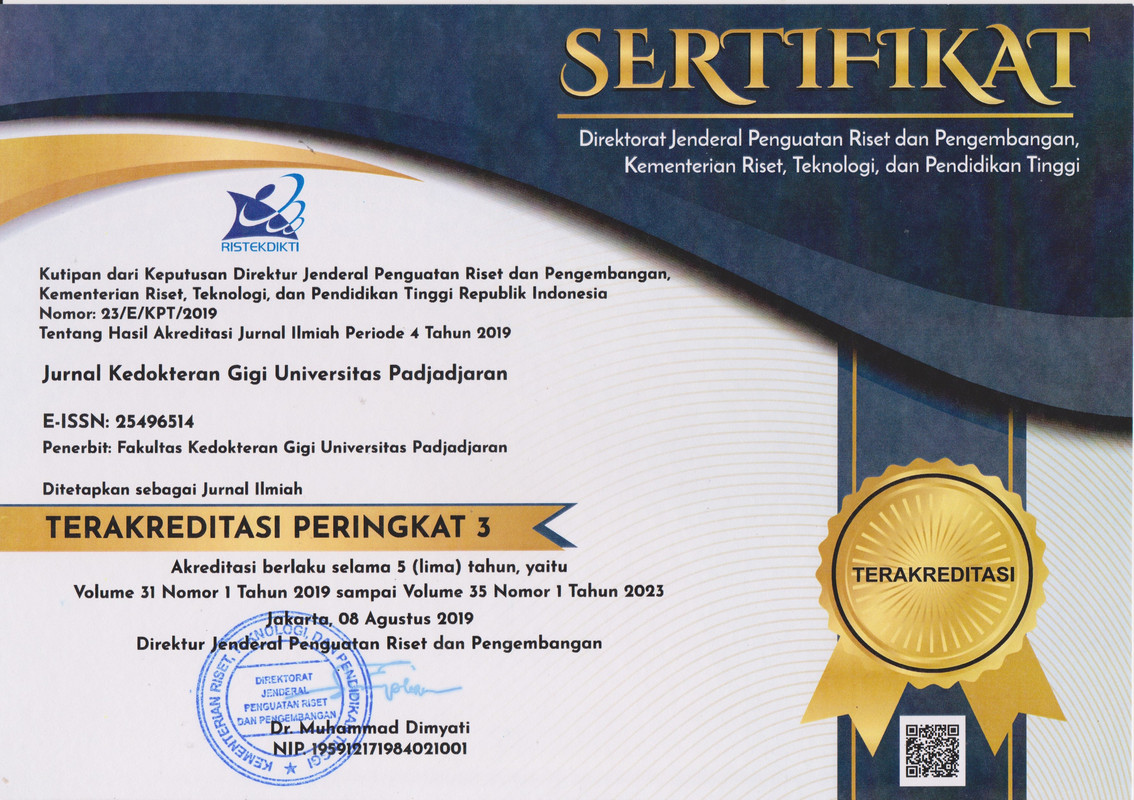Gejala klinis dan faktor penyebab kelainan temporo mandibular joint pada kelas I oklusi Angle
Clinical symptoms and aetiological factors of temporomandibular joint abnormalities in Angle class I occlusion
Abstract
Pendahuluan: Temporomandibular joint (TMJ) adalah sendi engsel yang menghubungkan tulang rahang atas dengan rahang bawah antara tulang temporalis dengan kepala kondilus mandibularis. Penderita kelainan TMJ dapat menunjukkan satu atau lebih gejala berupa bunyi kliking, krepitasi, nyeri sendi, nyeri otot, nyeri kepala, nyeri telinga, telinga berdengung, keterbatasan gerak mandibula, deviasi, dan defleksi. Faktor penyebab terjadinya kelainan TMJ dapat berupa maloklusi seperti crowded, crossbite, edentulus gigi posterior, atau kebiasaan buruk misalnya mengunyah satu sisi, bruksism, dan stres. Tujuan penelitian ini untuk mengidentifikasi gejala klinis dan faktor-faktor penyebab kelainan TMJ pada klas I oklusi Angle. Metode: penelitian ini merupakan penelitian deskriptif dengan rancangan cross sectional terhadap 33 penderita kelainan TMJ kelompok umur 18-24 tahun, Klas I Oklusi Angle. Pengumpulan data diperoleh melalui kuesioner berupa anamnesis dan pemeriksaan klinis. Hasil: Gejala tertinggi yang dialami penderita kelainan TMJ klas I oklusi angle berupa kliking (72,7%). Faktor-faktor pendukung terjadinya kelainan TMJ adalah stres (45,5%). Berdasarkan kebiasaan buruk tertinggi yaitu penderita mengunyah satu sisi (48,5%). Tingkat Helkimo’s anamnestic index (Foncesa 1992) diperoleh kelainan TMJ tertinggi berupa kelainan TMJ ringan (72,73 %). Berdasarkan RDC/TMD (1992) diperoleh bentuk kerusakan TMJ tertinggi berupa dislokasi diskus dengan reduksi (42,22%). Simpulan: Gejala klinis kelainan TMJ pada Klas I Oklusi Angle menunjukkan gejala lebih dari satu sampai tujuh gejala dan faktor penyebabnya adalah kondisi gigi crowded, crossbite, edentulus gigi posterior, kebiasaan buruk seperti bruksism, mengunyah satu sisi, menopang dagu, tidur satu sisi, mengunyah makanan keras, kondisi stres, perawatan ortodonti.
Kata kunci: Temporomandibular joint (TMJ), kelainan TMJ, oklusi kelas I angle.
ABSTRACT
Introduction: The temporomandibular joint (TMJ) is a hinge joint that connects the maxillary bone with the lower jaw between the temporal bone and the head of the mandibular condyle. People with TMJ abnormalities can show one or more symptoms in the form of clicking, crepitations, joint pain, muscle aches, headaches, ear pain, ear buzzing, limitation of mandibular motion, deviation, and deflection. Factors causing TMJ abnormalities can be malocclusions such as crowding, crossbite, posterior dental edentulous, or bad habits such as one side chewing, bruxism, and stress. The purpose of this study was to identify clinical symptoms and factors that cause TMJ abnormalities in class I Angle occlusion. Methods: This study was a descriptive study with cross-sectional design of 33 patients with TMJ abnormalities in the 18-24 years old age group, class I angle occlusion. Data collection was obtained through questionnaires in the form of history taking and clinical examination. Results: The highest symptoms experienced by patients with TMJ class I occlusion angle abnormalities in the form of clicking (72.7%). Supporting factors for TMJ abnormalities are stress (45.5%). Based on the highest bad habit, the sufferers chew one side (48.5%). The level of Helkimo's anamnestic index (Foncesa 1992) obtained the highest TMJ abnormalities in the form of mild TMJ abnormalities (72.73%). Based on RDC / TMD (1992) obtained the highest form of TMJ damage in the form of disc dislocation with reduction (42.22%). Conclusion: Clinical symptoms of TMJ abnormalities in Class I Angle occlusion shows more than one to seven symptoms and the causes are crowded teeth, crossbite, posterior edentulous, bad habits such as bruxism, chewing on one side, supporting the chin, sleeping on one side, chewing hard food, stress conditions, orthodontic treatment.
Keywords: Temporomandibular joint (TMJ), TMJ disorder, class I angle occlusion
Keywords
Full Text:
PDFDigital Object Identifier
DOI : https://doi.org/10.24198/jkg.v31i2.21440Dimension Citation Metrics Badge
Refbacks
- There are currently no refbacks.
Copyright (c) 2019 Jurnal Kedokteran Gigi Universitas Padjadjaran
INDEXING & PARTNERSHIP
Refbacks
- There are currently no refbacks.
Copyright (c) 2019 Jurnal Kedokteran Gigi Universitas Padjadjaran
INDEXING & PARTNERSHIP

Jurnal Kedokteran Gigi Universitas Padjadjaran dilisensikan di bawah Creative Commons Attribution 4.0 International License






.png)
















